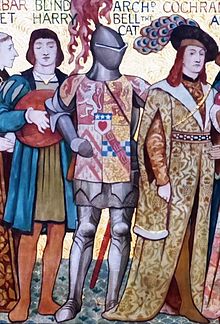Archibald Douglas, 5th Earl of Angus
| Archibald Douglas | |
|---|---|
| Earl of Angus | |

Archibald 'Bell-the-Cat' depicted as a notable figure in Scottish history by the Victorian artist William Hole
|
|
| Predecessor | George Douglas, 4th Earl of Angus |
| Successor | Archibald Douglas, 6th Earl of Angus |
| Father | George Douglas, 4th Earl of Angus |
| Mother | Isabella Sibbald |
| Born | 1449 |
| Died | October 1513 Whithorn |
| Buried | Whithorn Priory |
Archibald Douglas, 5th Earl of Angus (1449 – October 1513), was a late medieval Scottish magnate. He became known as "Bell the Cat". He became the most powerful nobleman in the realm through a successful rebellion and established his family as the most important in the kingdom.
Angus, born about 1449 at Tantallon Castle in East Lothian, succeeded his father, George Douglas, 4th Earl of Angus, in 1462 or 1463 at the age of just fourteen.
In 1481, Angus became Warden of the East March, but the next year he joined the league against James III and his favourite, Robert Cochrane, at Lauder. Here he is said to have earned his nickname by offering to "bell the cat"—specifically, to deal with Cochrane—beginning the attack upon him by pulling his gold chain off his neck, and then ordering the hanging of Cochrane and others of the king's favourites from Lauder old bridge (the site of which is in the grounds of Thirlestane Castle). The earliest written source for the story is in David Hume of Godscroft, the Douglas family biographer. The phrase "to bell the cat" comes from the fable "The Mice in Council", erroneously ascribed to Aesop, and refers to a dangerous task undertaken for the benefit of all.
Subsequently he joined Alexander Stewart, Duke of Albany, in league with Edward IV of England on 11 February 1483, signing the convention at Westminster which acknowledged the overlordship of the English king. However, in March Albany and Angus returned, outwardly at least, to their allegiance, and received pardons for their treason.
...
Wikipedia
